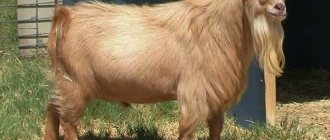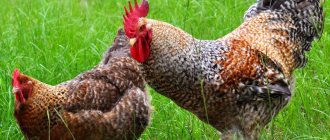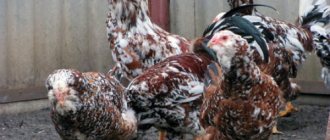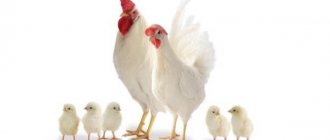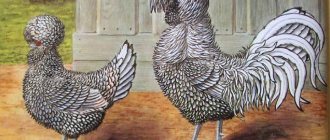How the breed was developed
The name of the breed is associated with the characteristic color of the plumage, which is represented by fox, bright red shades. Hungarian breeders worked on breeding birds, wanting to get a productive variety of chickens for home keeping. Soon they brought the first individuals of the hybrid to Europe and Russia. In England they are called "bald chicken", and in other countries "red broiler" or "Hungarian giant". This is due to the large size of the body and the color of the feathers.
Representatives of the breed have a small head with orange eyes, yellow paws and beak, as well as a massive chest and back.
The young initially grow in height and then in width. Because of this feature, some poultry farmers often confuse Foxy Chick with other breeds.
Origin, description and characteristics of the breed
The bird got its name from its bright red fox color. Birds originally appeared among the Hungarians; later, having gained popularity among many farmers, chickens were brought to many European countries, including Russia. The bird has more than one name, which translated from English means “fox chicken”. The bird is often called the Hungarian giant and the red broiler. This is directly related to the large size of the birds and their color.
The distinctive features of the breed include a small head with orange eyes, a yellow beak and paws of the same shade. The birds have a large, strong body, short stature, and a wide back and chest. Foxy Chick chickens first grow upward, then begin to grow wider. This feature often causes farmers to confuse the breed with other species.
Chickens have a medium-sized comb, slightly inclined to the side. The color of the plumage is bright red, sometimes with a brown tint. The feathers are dense, thanks to which the bird is protected from severe frosts. This breed tolerates frost and cold well.
Character
Foxy Chick chickens have a calm character, which is why there are rarely any difficulties with their maintenance. Farmers describe birds as active, curious and calm animals. Chickens are able to get along well with other inhabitants of the yard, and males carefully guard their family, but will not rush at strangers without a known reason. But roosters and hens of this breed can constantly argue and fight among themselves, so it is advisable to leave no more than one male in the herd.
Red broilers are noisy birds: if a stranger approaches the enclosure, they will immediately begin to cackle and flap their wings, notifying their owner. Females of this breed are distinguished by a well-developed brooding instinct - they are able to raise not only their own, but also other people's chickens. One hen can hatch 9-10 chicks at a time.
Productivity
The body weight of chickens of this breed is especially impressive. One adult bird can weigh around 3.5-4 kg, while roosters are the leaders among all poultry and weigh up to six kilograms.
Even from birth, chicks, having a thin body, look much larger than babies of other breeds of the same age. For example, at 20 days old the weight of the chicks is about half a kilogram, and at the age of one and a half months their body weight already reaches 1.4 kg. Birds develop and grow quickly.
The table shows the age of the bird and its approximate weight during this period:
| Bird age | Weight |
| 21 day | 460 g |
| 28 days | 690 g |
| 35 days | 980 g |
| 42 days | 1.37 kg |
| 49 days | 1.73 kg |
Raising for slaughter is beneficial not only due to the large weight of the birds, but also due to the fact that the products have excellent taste. Bird meat is juicy and tender, dietary, containing a minimum amount of fat.
Birds reach sexual maturity at the age of 4 months, sometimes later. During the year, a laying hen produces about 260-300 eggs, while representatives of other breeds produce no more than 160-180 eggs. If you properly care for the females, even in winter the chickens will continue to lay eggs.
The weight of one egg is 60-70 g. Large eggs with a light brown or beige dense shell. The size of the eggs increases significantly as the bird matures, reaching its maximum volume within a month after the first laying. But when the peak of productivity ends, production becomes less again. The disadvantage of birds is the short period of productive egg production - about 1 year. If the bird has reached two years of age, after the clutch has been reduced, it is sent for slaughter.
External data of Foxy Chick chickens
“Fox” chickens differ from other crosses by having a stocky and strong body, the size of which is larger than the average. The body is set high on the ankles, and the body itself is compact and rounded. The wings are proportional in size and tightly pressed to the body.
Exterior Features
The description of the breed mentions a fiery red or orange-brown color with varying degrees of saturation. Chickens have a characteristic shine to their plumage, but it fades over time. The feathers are quite dense, so the chickens are not afraid of harsh climatic conditions. The most common shade is red-brown. If a laying hen has a black cover, this indicates that it belongs to the category of hybrids.
Foxy Chick chickens are orange-brown in color.
Other distinctive exterior features include:
- Short but muscular limbs.
- Wide neck and chest.
- Average beak length.
- Short tail, located at an angle of 45° relative to the body.
- Thick feather cover.
The chicks of this cross are quite thin, but as they grow older they rapidly gain weight and acquire a heroic appearance.
Differences between roosters and hens
Males differ from females in having a richer shade of feathers. In addition, their weight reaches 6-7 kg, while chickens weigh no more than 3.5-4 kg.
Possible defects
Rejection of birds occurs in the presence of the following defects in appearance:
- Twisted and heavy bones.
- Light shade of eyes, plumage and fluff.
- White plaque on the limbs and other parts of the body.
- Irregular body shape.
Description of the breed
Photo:
Foxy Chick chickens are large birds; if feeding conditions are met, adults can gain up to 4 kg of weight, roosters - up to 6 kg. They have a squat and broad body, a powerful body.
Short and powerful legs, as well as red feathers, have become the hallmark of the breed. The color of the plumage can vary from fiery to almost brown depending on the conditions and age of the bird.
External features of the breed, description:
- a rather large head with a straight red leaf-shaped crest;
- bright red round earrings;
- the eyes are slightly bulging and have an orange iris;
- beak of medium length, usually yellow;
- very wide and massive neck;
- the wings are poorly developed and lie close to the body;
- the tail is small, located at an acute angle to the body.
The key factor in breed rejection is slow weight gain, as well as plumage color that does not meet the standard. This breed is characterized by an active and pugnacious nature.
The birds are very active and have contact with humans, but when kept with other breeds they can attack smaller individuals, and due to their large weight the situation can result in serious injuries.
With increased crowding in the chicken coop, there is a risk of cannibalism.
Temperament of the Foxy Chick breed
Hungarian giants cannot be called a calm breed. Laying hens often show aggression towards other species, so keeping them in a poultry house with other domestic birds is not recommended. In addition, you cannot leave more than 1 sexually mature male in the herd. In some cases, females conflict with each other, but they do not fight to the point of blood, like roosters.
Foxy Chick often shows aggression.
Red broilers get into fights with laying hens of other breeds, and sometimes kill them due to their large body weight.
Increased pugnacity is a characteristic feature of the cross, so there is no need to blame yourself for not following the rules for caring for birds. Chickens fight all the time and it cannot be avoided. Often, adult males attack people, so when visiting a poultry house, it is important to take a broom with you, which will allow you to fight off an aggressive rooster without causing him physical harm. It is better to replace the most violent individuals with others.
Character traits also include the loudness of birds. If someone passes near the enclosure, the animals will begin to cluck loudly for a long time.
Red broilers are quite active and inquisitive, so the area for their walking needs to be made spacious. Laying hens love to expend their extra energy by digging in the soil in search of worms. Therefore, the owner of the livestock needs to take care of access to land.
Keeping and raising chickens and laying hens
Cross Foxy Chick is unpretentious, gets along in any climate zone, is not afraid of cold and can be kept in a room without heating. The main thing that can be done is to insulate the floor with sawdust, peat or straw. This organic layer releases heat and the coop heats up.
In summer, the room needs to be ventilated more often. An aviary - a place for walking - is built on the south side of the chicken coop. The fence must be placed high so that the chickens do not fly free. A passage is installed from the chicken coop to the aviary. In winter, he should cover himself with a shield. From three weeks, the chicks begin to walk in the enclosure, if the weather is favorable.
Inside the poultry house they place closed feeders, shelves and a container with ash for chickens (to cleanse them of parasites). Bird nests are made from the floor at a height of 80 cm.
Bacteria and other microbes actively multiply in stale air, which can harm birds. To avoid this, treat the walls and change the bedding on the floor in a timely manner.
Chickens adapt remarkably well to natural conditions and obtain food without much effort, which is beneficial for farming in terms of feed for poultry.
The room must be maintained at normal humidity and removed during droppings, otherwise egg laying will decline.
Nutritional standards for chickens and adults (feeding)
Red Bro chickens are fed with compound feed until 21 days. To diversify the chickens' diet, add a mixture of grain with a chicken egg, gradually expanding it (include vegetables and herbs - clover, nettle).
Chicks locked in a poultry house must be supplemented with fish oil.
A little later, chalk, meat and bone meal and fish meal are added to the diet. Adults are fed barley, corn, and wheat porridge.
Make sure you always have fresh water, this is important because all food is given dry.
Approximate feed standards for chickens, g per head per day
With a sudden change in food products, Foxy Chick loses his appetite; the transition from compound feed to main food should be smooth.
Development of the brooding instinct
The red broiler is one of the few varieties of highly productive chickens that not only actively lay eggs, but also perform their maternal duties efficiently. Thanks to the developed brooding instinct, the birds do not leave the nest and carefully care for the chicks. In addition, they do not give up the role of “stepmother”, so they are able to raise foundlings or cubs of other hens.
This feature increases the survival rate of offspring to 100%. But egg-laying and incubation of offspring is accompanied by the expenditure of a large amount of energy, so during this period the chicken must be properly cared for.
Breeding specifics
Females are excellent at incubating eggs and raising chicks, but due to their large weight they can sometimes damage clutches.
Laying hens actively demonstrate maternal instinct - readiness to incubate eggs and raise offspring
There is one more, much more significant disadvantage of this variety of chickens: it is the result of interbreeding (cross). This means that descendants do not fully inherit the positive qualities inherent in their parents. Some breeders claim that differences of this kind practically do not appear in the first generation of chickens obtained from purebred parents, but this data has not yet been widely confirmed. More reliable is the information that when crossing Foxy hens with Orpington (fawn or red) and Rhode Island roosters, chickens are obtained whose characteristics are very close to those of the Hungarian Giants.
In any case, to start growing and breeding Foxies, you need to purchase hatching eggs or chickens from reliable breeders with a solid reputation.
Egg production and productivity table
| Egg production rate (pieces per year) | Egg weight (g) |
| 260-300 | 60-70 |
The increase in live weight for individuals of the Hungarian Giant cross is as follows:
| Age (days) | Weight (kg) |
| 21 | 0,46 |
| 28 | 0,69 |
| 35 | 0,98 |
| 42 | 1,37 |
| 49 | 1,73 |
Large eggs have a beige or light brown tint with a dense shell. The size of the product increases as the hen matures, and the maximum volume is reached a month after the first egg laying. In this case, productivity is maintained only for 1 year. When the chicken reaches 2 years of age, it must be sent to slaughter.
Owner reviews
Vera, 38 years old, Orel
I have been keeping these birds for several years now. I'm very pleased. They require minimal care. It is enough to provide balanced feeding and extensive walking. They lay perfectly, the eggs are tasty and there are a lot of them. The brood hens are wonderful: they hatched chicks from both their own eggs and others, and there was almost no waste. I was warned that this is a cross, and the next generations will be worse than the parent ones, but I did not notice any serious differences. We slaughter the cockerels for meat - very tasty and juicy. The only drawback, in my opinion, is pugnacity. You cannot leave two males in the herd: they will fight to the death. Roosters of other breeds are also abused. It's better to keep them separate.
Denis, 45 years old, Bryansk
Great breed. I keep them almost exclusively for the eggs. From each laying hen I get 280-290 pieces per year; The eggs are tasty and large. True, there are breeds that are more “durable”, but these have to be changed every two years. But the meat is of quite decent quality, even from culling. I haven’t tried to hatch them myself: they say egg production is not inherited.
Anna, 52 years old, Perm
For some reason they recommended these chickens to me as broilers. I bought 20 day old chicks in the spring. Everyone survived, grew very quickly, and did not get sick. At one and a half months, the cockerels already weighed almost 2 kilos, looked vigorous and cheerful. In the fall, I sent the roosters for meat, and 8 hens hatched. There were unexpectedly a lot of eggs. There were no problems with wintering at all: our winters are harsh, but the birds lived well in an ordinary, slightly insulated barn on thick bedding. In general, I am now a fan of this breed. There are no problems with care, the eggs and meat are wonderful. I will buy more eggs for hatching or chickens and expand the flock.
Keeping and caring for chickens
Representatives of the cross are distinguished by their unpretentiousness to their environment. However, they react negatively to extreme cold and are afraid of dampness and precipitation. Therefore, during winter overnight stays and unfavorable weather, they need to be provided with reliable shelter from the cold.
Decoration of the chicken coop
Steps to breed Hungarian giants begin with preparing the chicken coop in which they will grow. The building can be small, provided that it is equipped with a spacious walking yard. Individuals cope well with sudden weather changes, and in mid-latitudes it is not necessary to heat the house in winter. It is enough to lay straw on the floor, in which biological processes will take place, generating thermal energy. This layer is used as a natural heating system. Straw can be replaced with sawdust or hay.
For Foxy Chick you need to prepare a chicken coop.
In summer, the interior should be cool and fresh. To do this, you need to provide at least 1 opening window. Classic perches and feeders are suitable for keeping red broilers. The main thing is that the structures for feeding food have such a device that the birds will not be able to leave droppings in them or get their paws on them.
Perches can be made from poles with a cross-section of 4 cm. They need to be fixed at a distance of 80 cm from the floor level.
Walking yard
The walking yard is arranged on the south side, connecting it to the entrance of the building using grooves. In winter, these openings should be lined with wooden boards to prevent drafts from penetrating into the house.
In addition, you need to install a table near the chicken coop on which it will be convenient to prepare mash and feed. It is necessary to build a fence up to 1 m high along the perimeter of the yard.
If there is no possibility of arranging a walking area, it is enough to provide the supply of sunlight and air to the room. To do this, you can fence off a small area near the poultry house with a 2 m high fence. In this sector you need to install feeders and clean them regularly.
The taste characteristics of meat and the beneficial properties of egg products depend on free range. Walking does not stop until the temperature drops to -10°C.
Chick care
Due to their high productivity, Foxy Chick chickens are sold at high prices. Unscrupulous breeders often offer chicks of other breeds under the guise of red broilers, and ask for an identical amount for them. To eliminate this risk, it is recommended to purchase animals from a proven incubation station.
Foxy Chick chickens command a high price.
Outwardly, the chicks do not resemble their parents, but as they grow older, all differences disappear. Due to rapid growth, young animals quickly turn into mature roosters and hens.
At an early age, chickens look thin and have an elongated body. But by the end of the first month of life, their weight is 900-1000 g. After 60 days, the figure reaches 2 kg.
To obtain such growth rates, you need to take into account the basic rules for caring for young animals. You cannot feed chicks with traditional food for meat and egg chickens. Broiler feed is used instead.
Individuals that reach the age of 1.5 months switch to an adult diet. But it is better for them to grind their food to simplify the process of swallowing food.
When raising young animals, it is important to organize the correct supply of drinking fluid. For this purpose, ready-made or homemade drinking bowls are used. It is important to install the structures in such a way that birds do not knock them over and stain them with dirty paws.
During the first few weeks, the chicks are fed liquid heated to +40°C. Using cold water may cause the chicks to become hypothermic. A solution of ascorbic acid, which is sold in veterinary pharmacies in the form of glucose syrup, must be added to the drinking bowls.
Diet and feeding
Feeding adult birds is no different from feeding chickens of other breeds. When using dry feed for young animals, it is important to provide them with uninterrupted access to drinking water. Homemade mashes containing components containing protein are suitable.
Homemade mash is suitable for feeding chickens.
Among them:
- Boiled eggs.
- Dairy products.
- Green grass.
- Baker's yeast.
However, food prepared with your own hands quickly loses its freshness and becomes unsuitable for birds to eat. In addition, choosing the right ingredients and proportions is quite difficult. Industrial feed additives are produced with a balanced composition.
Care and maintenance of chicks
Chicks require excellent lighting to develop well. For the first ten days of life, the light should be constantly on. For the first 5 days of life, it is optimal to maintain the baby’s temperature at +30 degrees. At one month of age, +20 degrees is enough.
At first, the chicks are given high-quality feed (for broiler breeds). In this case, simple food for feeding young animals is not suitable for birds of meat and egg production.
After the chickens have dried and are actively moving, farmers include fresh cottage cheese and fish oil in the diet, and also feed the chicks boiled eggs in crushed form. Small birds should not eat whole grains and milk, because their stomachs are still weak and cannot cope with the digestion of these products.
After the birds are one and a half months old, they begin to be fed with crushed “adult” food so that it is digested faster and better absorbed by the body. It is important to feed the young animals with clean, fresh water. It is necessary to install drinking bowls in the poultry house so that they are difficult to get dirty. First, the chicks are given warm water at least 40 degrees to avoid hypothermia. It is recommended to add a little ascorbic acid solution to the drinking bowls.
Puberty at Foxy Chick
Hungarian giants are characterized by a high rate of puberty. This feature makes them a popular meat and egg breed for keeping in a private backyard. The first laying of eggs occurs at 4 months, while establishing the process takes no more than 4-5 weeks.
However, a 4-month-old chicken is not fully formed, since the maturation process continues until 1 year.
Weight gain lasts up to 12-14 months, and sometimes up to 1.5 years.
In rare cases, laying hens are susceptible to health problems that disrupt the development and maturation cycle. This can also be due to deviations from the diet and care rules.
Types of breeds
Colored broilers are divided into two types: Red Bro (Foxy Chick) and Master Gray.
Red broiler
Red Bro chickens are relatively healthy and are raised without the use of drugs (antibiotics). The red broiler is famous for its tasty meat and high egg production. These chickens can be compared to Master Gray broilers. Red Bro differs from Master Gray in 100% survivability. It is more profitable to breed red broilers than Master Gray.
A more detailed description of the Master Gray chicken breed can be found in this material.
The name Red Broiler suits this bird perfectly and matches its appearance.
Master Gray
Master Gray poultry is not inferior in advantages to the red broiler, although it is noted that it lays slightly fewer eggs. Also, the disadvantages of this breed include a short period of productivity and the birds’ lack of instinct to hatch eggs.
The appearance of the chickens is slightly different; many representatives of the cross have a gray-white plumage color. The feathers may have black or reddish spots.
The advantages of these individuals are their calm nature; they do not like cockfights. Another disadvantage of this cross is that the chicks are small. Individuals grow quickly, but their plumage is slightly slower.
Master Gray chickens belong to the meat-egg category and are hybrid birds. Therefore, it would be more accurate to call Master Gray chickens not a breed, but a cross.
Subtleties of breeding
Red broilers belong to the category of crosses, and the possibility of breeding them becomes more difficult, since subsequent generations will split into the original subspecies. The productivity indicators of the second brood will be greatly reduced.
Foxy Chick broilers are difficult to breed.
To breed a cross at home, you need to purchase eggs from representatives of a trusted hatchery. The product must be medium in size and have a clean shell. At the selection stage, using an ovoscope, you should check the central placement of the yolk and the position of the air chamber at the blunt end.
At the incubation stage, it is enough to turn the eggs in time and monitor the microclimate in the room where the equipment is installed. Chicks with similar properties can be obtained by crossing the Rhode Island or Orpington breeds.
Each option provides for the appearance of a bias in characteristics towards males.
Content
In general, Foxy Chick chickens are unpretentious. When maintaining them, special attention should be paid to insulating the chicken coop. It is advisable to use straw or sawdust as bedding in a layer of 10-12 cm.
To prevent birds from overheating, a ventilation system should also be planned. Perches are placed at a height of up to 80 cm above the floor, the optimal diameter of the perch is 4 cm. Since the breed is very active, it is recommended to think in advance about the walking space where the birds spend most of the daylight hours.
In winter, the birds are transferred to a well-insulated room, where optimal humidity is maintained at 75-80%; temperature – 15-20°C.
Artificial lighting is a must, since shell formation and bird health require long daylight hours (11-13 hours). The chicken coop should be cleaned regularly, deratization and disinfection should be carried out at least 2 times per season.
For the first 10 days, the young animals are kept in a brooder, maintaining warmth and humidity. Then they can be released for walking in a limited and treated area.
Molting period and break in egg laying
Egg laying in Hungarian giants continues almost the entire year. But during seasonal molting, productivity decreases as Foxy Chick chickens stop laying eggs.
During seasonal molting, chickens stop laying eggs.
Having noticed that the condition of the birds has worsened, their plumage has become shabby and shabby, you should immediately reduce the length of daylight hours. Such actions make it possible to simplify the process of natural molting without forced stimulation.
The period of high productivity lasts up to 1 year. After this it gradually decreases. 2-year-old chickens can be slaughtered for meat.
Farmer reviews
Vladimir Ivanovich, Kyiv, 54 years old.
I started Foxy Chick 7 months ago. I can tell you about my content experience. Now, as is already clear, the chickens are 7 months old, they still haven’t given eggs. I keep the bird under normal conditions, without special feed or temperature conditions. They gain weight much worse than broilers, but when compared with ordinary chickens, they are an order of magnitude better. The big minus of this breed is that they eat non-stop. Always hungry, you throw food and rush straight away. In general, breeding for meat is not profitable; it will not pay off due to the high costs of feed. Although if you grow it for home use, purely for the sake of high-quality fresh meat, it will do. The meat is really tasty. I can’t say anything about the eggs; not a single clutch has been laid yet.
Olga Ivanovna, Rostov, 56 years old.
We have not kept chickens of this breed, but I have a good friend who keeps them. Overall, I'm 100% satisfied. And they give eggs, and they lay very well, and the meat is good, the chickens grow up well-fed. That's all I can tell you about this breed.
Common diseases and their prevention
The survival rate of the livestock will reach 100%, provided that the breeder follows all the rules of feeding and caring for the cross. In order for red broilers to feel good and not be susceptible to disease, preventive measures must be taken.
Among the common pathologies to which chickens are exposed are:
- Marek's disease. Leads to cramps, lameness, loss of the natural shade of the eyeball and an increase in goiter. There are no ways to combat the disease, so the poultry farmer needs to regularly take preventive measures.
- Coccidiosis. The disease causes loss of appetite, loose stools and lameness. Experts recommend using Sulfadimezin, Coccidiovit or Amprolium for treatment. Folk compositions based on sulfur or iodine are also suitable for eliminating symptoms. To prevent coccidiosis, you need to clean feeders and drinkers every 2 weeks, replace bedding and remove food debris after each meal.
- Intestinal infections, worms, ticks. Parasites often infect birds by sucking their blood. Laying hens are bothered by severe itching and loss of appetite. Treatment involves the use of effective insecticides. An ash bath shows good results in combating the problem.
- Pasteurellosis. When the acute form of the disease develops, the birds feel depressed, stop eating food and suffer from mucous diarrhea and difficulty breathing. The chronic stage is accompanied by wheezing, runny nose and swelling of the ridge or paws. It is impossible to cure pasteurellosis, so infected individuals must be disposed of. The drug Levomycetin is suitable for prevention.
For chickens, preventive measures need to be taken.
conclusions
- A cross called Foxy Chick is the best-characterized meat-egg hybrid
- It is unpretentious in care, cultivation and maintenance.
- The productivity of meat and eggs is excellent.
- Externally, the Foxichik chicken is attractive, like Redbro, with thick plumage.
- Chicken survival rate – 100%
- With proper care, they practically do not get sick.
- This breed has a weak maternal instinct, so it is advisable to use incubators for their breeding. The Laying Incubator is considered a good model in the budget category.
You can read about proper incubation of chicken eggs in this article.
Pros and cons of the breed
The Foxy Chick chicken breed has many advantages. Farmers value it because of:
- Unpretentiousness to living conditions. Birds do not require complex care, are not afraid of sudden cold snaps and frosts, and quickly adapt to different climatic conditions.
- Rapid growth. Young individuals quickly gain the weight of an adult bird and increase in size.
- Strong immunity. Hungarian crosses are practically disease-free and are famous for their high resistance to common poultry diseases.
- High taste qualities of the meat product. Animals provide a lot of tender, juicy and dietary meat.
- Undemanding to food. You can feed the birds both commercial feed and homemade mash. If you have a walk, the costs of catering will be greatly reduced.
- Developed hen instinct. Females perform their maternal functions efficiently and take care of young offspring. This increases the survival rate of young livestock.
- High egg productivity. Due to early puberty, birds lay a record number of eggs per year - up to 300 eggs.
The disadvantages of representatives of the breed include a quarrelsome nature and pugnacity. In addition, they quickly lose their initial productivity, so the farmer needs to regularly update the stock.
Reviews
Poultry farmers note the unpretentiousness of keeping, as well as cost-effective breeding of chickens. The survival rate is very high, and the chicks quickly gain weight. In addition, laying hens of the breed demonstrate high egg production, maintaining it for a long time.
Among the disadvantages of the breed are pugnacity, as well as increased sensitivity of birds to cold and humidity. If you have a well-thought-out chicken coop and comply with all conditions of maintenance, problems with Foxy chick chickens appear extremely rarely.
Reviews from poultry farmers
Victoria , 39 years old, Chernigov: “I learned about the existence of the breed from photos that I received from a friend. After studying the reviews, I decided to purchase several chicks. To begin with, I bought 20 individuals, which were distinguished by their cheerful character and active behavior. During the time they were kept, the young animals never got sick, which is good news. Within 30 days from the date of purchase, I used boiled eggs for feeding, and then mixed them with crushed nettles. Adult chickens were given corn and millet. In a week, a laying hen produces about 5 large eggs.”
Kirill , 28 years old, Krasnodar: “I met birds at the local market. The birds immediately captivated us with their beautiful appearance with fiery plumage. Initially I bought 10 chicks, but soon decided to expand the population. From one hen I get up to 280-290 large eggs per year and a large amount of tasty meat.”
Svetlana , 56 years old, Ryazan: “There are 30 cross-breeds in my yard. An adult chicken weighs 4-5 kg. Laying hens produce large eggs and do not require complex care. I recommend it to all beginning farmers and breeders.”
Advantages and disadvantages of a hybrid
Chicken is highly valued in Europe because of the number of positive qualities it possesses. Among the main advantages of Foxy it is worth noting:
- Chickens gain weight very quickly, which makes the cross an ideal meat chicken.
- Foxy Chick is unpretentious in terms of nutrition.
- They ripen very quickly and begin to produce eggs.
- They have fairly high egg production rates (about 250 eggs per year).
- The bird has a very strong immune system.
- Foxy Chick meat is highly valued because it is dietary, nutritious and very tasty.
- Crosses have not lost their maternal instinct and very often laying hens become hens.
- This is an economically profitable bird that can be used as a laying hen, and then for meat.
But of course, like any other hybrid and breed, Foxy has its drawbacks. First of all, this is a fairly short period of high egg production. The productivity of a chicken drops significantly within a year after the first laying. Taking into account also the fact of seasonal declines in productivity (during molting), in commercial farming conditions this chicken is not considered a serious cross for production.
Another drawback is the pugnacious nature of the cross. Roosters will regularly start fights if there is more than one male in the flock.
Breeding offspring
Cochin chickens
You can get Cochin offspring by placing a hen on eggs or using an incubator. The best method of breeding these chickens remains the placement of a brood hen. In this case, chickens grow up with well-developed immunity and do not require special care.
On a note! It is recommended to feed babies in the first days of life with mash with the addition of cottage cheese or kefir. In the second week, you can introduce a small amount of compound feed into the diet, which contains many substances useful for growth and development.
Kids often get their feet into the feed, which greatly pollutes it. Therefore, during the feeding process, do not forget to clean the feeders so that they do not grow mold or other bacteria that will cause disease.
When the chickens have grown significantly, they are fed:
- cereals (semolina, corn, rolled oats);
- pumpkin;
- potato;
- carrot.
Breeding
Foxy Chick chickens are bred by crossing with the following breeds:
- rad Island,
- Orpington.
Breeding methods:
- Naturally (under the mother hen). Foxy hens have a good maternal instinct, hatch and protect the babies, and monitor their diet. This method frees the farmer from such worries.
- In case of mass breeding, incubation is used. The hatching percentage reaches 100.
The choice of breeding method depends on the owner’s employment and farm production volumes.
Feeding
The diet of Foxy Chick chickens is no different from the menu of other chickens. It should be balanced, rich in vitamins and microelements. In the summer (while walking), laying hens collect the necessary bugs and grass. This provides them with useful substances and vitamin components. The farmer must take care of the following products in the chicken menu:
- Grain (raw and cooked) enriches the chicken's daily feeding with carbohydrates and proteins.
- Meat and fish (can be added to the mash) replenish the body's reserves of animal protein.
- Whey and cottage cheese introduce calcium into the body for good plumage and development of the skeletal system.
- Mash from kitchen waste includes boiled vegetables, cereals, and potato peels.
- Raw and boiled vegetables contain many vitamins necessary for the growth and development of birds.
Compound feeds, premixes and mineral supplements should be present in the diet of chickens of any breed. Free access to fresh water is required. Foods are introduced to babies gradually. They begin to feed them with finely crushed egg yolk. Then boiled cereals and vegetables are introduced. You can use special feed for nursing young animals.
Important! If the chickens are kept together with the mother, she independently takes care of their diet.
Features of poultry keeping
These birds are not whimsical and easily tolerate different climatic conditions. A chicken coop, even in the northern zone, does not require insulation, but the nests will still have to be made warm. To do this, it is recommended to make deep bedding in them, and hang a thick curtain made of woolen fabric at the entrance. Hungarian giants, like other breeds, cannot tolerate drafts. The floor of the poultry house is covered with straw and sawdust. To prevent the bird from overheating during the summer months, you should make at least 1 opening window in the barn.
Perches are set up 80 cm from the floor, the cross-sectional diameter of which should not exceed 4 cm.
Care
The chicken is unpretentious and does not require complex care. It is enough to simply clean the poultry house 4 times a year and whitewash its walls with lime, which acts as an antiseptic, once a year.
When outside, chickens should have access to clean sand or ash to bathe in.
Vaccination of birds on a farm with less than 100 birds is carried out only under unfavorable disease conditions.
Feeding
Chickens need to be fed well.
Their menu must include:
- corn;
- compound feed;
- vegetables;
- roots;
- grass;
- hay;
- meat waste;
- fish waste;
- bran;
- maggots.
In addition, feeding should include special mineral and vitamin supplements.
Chickens should always have clean and fresh water in their drinking bowls. In the summer months it should be changed in the morning and evening, and in the winter months - once a day. In winter, when pets are deficient in vitamins, you can pour nettle infusion or infusion of calendula flowers in water into the drinking bowls. This will allow the bird not to suffer from vitamin deficiency and not reduce its egg production.
Breeding
Raising poultry is not difficult, since the brooding instinct of chickens is highly developed, and they not only willingly sit on the nest, but also carefully raise chickens . The hen can also hatch duck and goose eggs. The use of an incubator is only necessary for the initial breeding of poultry, when there is no parent stock yet.
The egg must be incubated according to the instructions for the unit. If everything is done correctly, the young hatch together in 21 days . The chicks are strong and break through the shell well, and therefore do not require human assistance during hatching.
You need to buy incubation material from a safe place so as not to risk getting a questionable bird.
Raising chickens
Foxy Chick chickens are robust and are usually not affected by natural mortality.
Feeding babies should begin as soon as they are dry, giving them a finely chopped hard-boiled egg. Young animals need warming continuously during the first 3 weeks of life. Starting from day 3, chicks can be given starter feed for broiler chickens, which will allow the bird to quickly gain maximum weight.
If you follow the rules, raising poultry is not difficult, since, unlike other breeds, these chickens have strong immunity from birth. Vaccinations in a private yard do not have to be done.
When the hen that hatched the eggs remains with the chicken, breeding foxy chick is completely easy for the owner.
Egg production
Meat-egg quotas do not show record results either in terms of meat or egg production. They are balanced in their performance in these two areas. But the egg production of Hungarian quons is slightly higher than average, which made it even more attractive for farmers and poultry farmers.
If the average laying hen of this type of productivity produces approximately 200-220 eggs per year, then Hungarian hens exceed this number by 20-30%. During the year of oviposition, red quoits lay from 2600 to 300 eggs.
Not all egg breeds can boast such an impressive result. The shell is colored pale pink and has an average density, and the weight of the testicles ranges between 60 and 70 grams.
If at the beginning of her egg-laying “career” a hen lays small eggs, then closer to the peak of productivity their weight becomes maximum.
Cross breeding
The very concept of “cross” already excludes the possibility of breeding, since in the second generation there will be splitting into the original breeds. Moreover, since the inheritance of genes of highly organized organisms is complex, the offspring will have an arbitrary mixture of characteristics of the parent breeds. As a result, the second generation hybrids will be significantly inferior in their productive characteristics to the Foxy Chick cross.
Hatching and hatching chickens is not about chickens of any of the specially bred crosses. To obtain eggs, birds need to be equipped with nesting boxes, and chicks will have to be hatched in an incubator.
You can come across claims that foxy are good hens. To understand that in these chickens the brooding instinct is completely absent or poorly developed, it is enough to check the productive characteristics. No hen that lays more than 200 eggs a year can be a good broody hen. She doesn’t have time for this, since she has to lay the eggs and molt them.
Attention! Molting in birds occurs after the end of the breeding period.
Thus, a chicken lays 20-30 eggs, incubates them for 21 days, then begins to lay eggs and incubate again, making 3-4 clutches per season, and “goes” to molt, eventually laying no more than 150 eggs per year. Second option: the chicken lays 300 eggs per year, leaving 2 months for molting. But in this case she does not incubate.
You can try to breed a foxy using an incubator if you add a rooster to them not of a similar breed, but of an Orlington or Rhode Island. In the first case, the offspring will retain their size, in the second, egg production.

